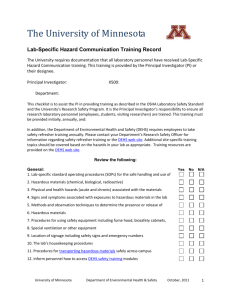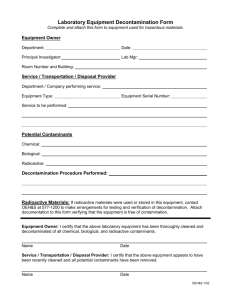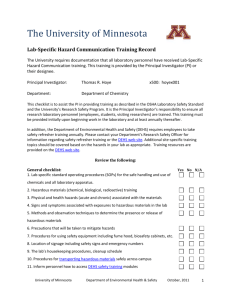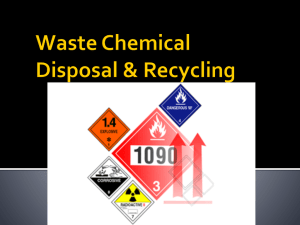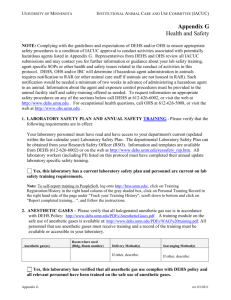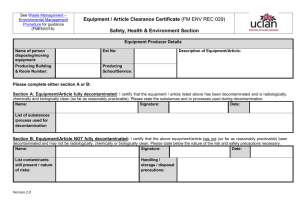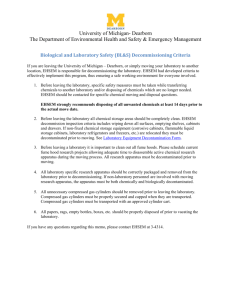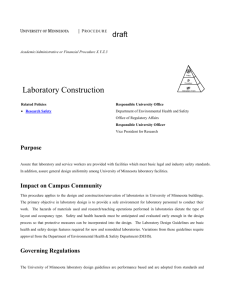Laboratory Closure and Decommissioning Procedure
advertisement
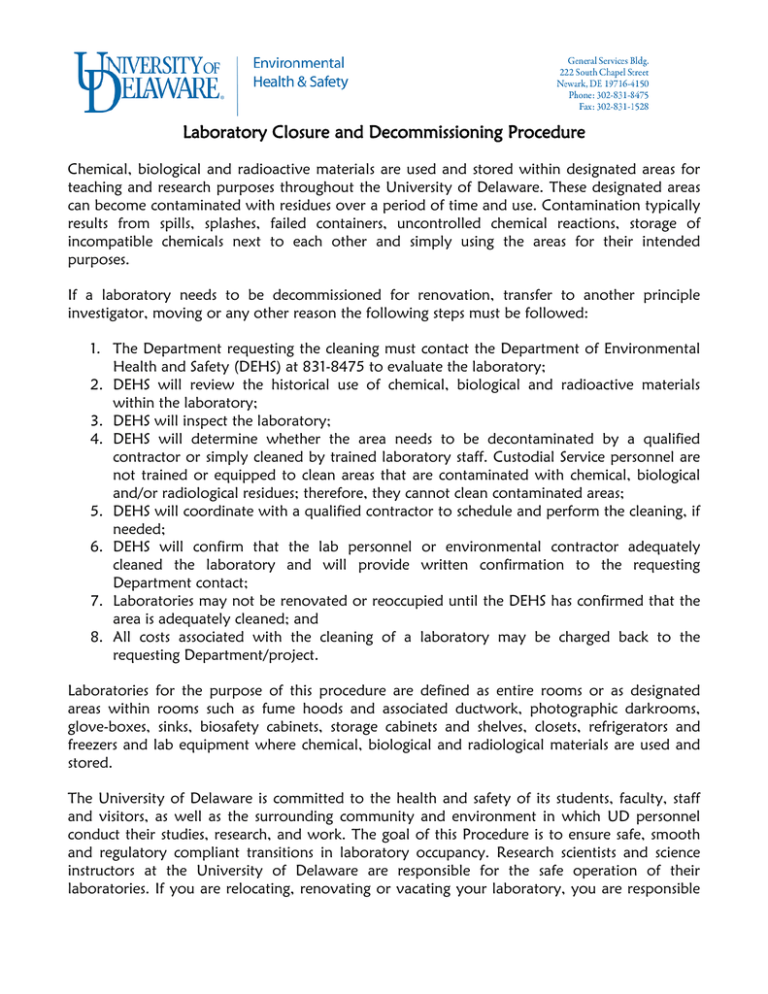
Laboratory Closure and Decommissioning Procedure Chemical, biological and radioactive materials are used and stored within designated areas for teaching and research purposes throughout the University of Delaware. These designated areas can become contaminated with residues over a period of time and use. Contamination typically results from spills, splashes, failed containers, uncontrolled chemical reactions, storage of incompatible chemicals next to each other and simply using the areas for their intended purposes. If a laboratory needs to be decommissioned for renovation, transfer to another principle investigator, moving or any other reason the following steps must be followed: 1. The Department requesting the cleaning must contact the Department of Environmental Health and Safety (DEHS) at 831-8475 to evaluate the laboratory; 2. DEHS will review the historical use of chemical, biological and radioactive materials within the laboratory; 3. DEHS will inspect the laboratory; 4. DEHS will determine whether the area needs to be decontaminated by a qualified contractor or simply cleaned by trained laboratory staff. Custodial Service personnel are not trained or equipped to clean areas that are contaminated with chemical, biological and/or radiological residues; therefore, they cannot clean contaminated areas; 5. DEHS will coordinate with a qualified contractor to schedule and perform the cleaning, if needed; 6. DEHS will confirm that the lab personnel or environmental contractor adequately cleaned the laboratory and will provide written confirmation to the requesting Department contact; 7. Laboratories may not be renovated or reoccupied until the DEHS has confirmed that the area is adequately cleaned; and 8. All costs associated with the cleaning of a laboratory may be charged back to the requesting Department/project. Laboratories for the purpose of this procedure are defined as entire rooms or as designated areas within rooms such as fume hoods and associated ductwork, photographic darkrooms, glove-boxes, sinks, biosafety cabinets, storage cabinets and shelves, closets, refrigerators and freezers and lab equipment where chemical, biological and radiological materials are used and stored. The University of Delaware is committed to the health and safety of its students, faculty, staff and visitors, as well as the surrounding community and environment in which UD personnel conduct their studies, research, and work. The goal of this Procedure is to ensure safe, smooth and regulatory compliant transitions in laboratory occupancy. Research scientists and science instructors at the University of Delaware are responsible for the safe operation of their laboratories. If you are relocating, renovating or vacating your laboratory, you are responsible for leaving your laboratory in a state suitable for re-occupancy or renovation. Department of Environmental Health and Safety must be notified of all moves or renovations in laboratory spaces. This form should be completed and forwarded to DEHS at least 45 days prior to exiting or reorganizing a laboratory due to renovation, exiting due to moving to another laboratory, or separation from the University. If there is more than one laboratory involved in this laboratory exit process, forms should be submitted at least 90 days in advance of the exit. This Procedure requires that proper laboratory decommissioning is conducted to include decontamination and cleaning of all laboratory equipment, fixtures, furniture and space. Principal Investigators, Departments, and Project Managers are equally responsible for complying with advanced notification and other requirements. These overlapping requirements are necessary because, depending on the situation, only one of these entities will have the ability to comply with this Procedure. Applicability This Procedure applies to: Research and teaching laboratories owned by the University of Delaware or occupied by University of Delaware faculty, staff, or students. Laboratories that use chemicals, radioactive materials, biological material, human pathogens, controlled substances, compressed gases, large equipment, mercury containing equipment, etc. Laboratories or ancillary research spaces (e.g. cold rooms, environmental chambers, freezers outside core laboratory space) that are vacated by an investigator. Laboratory space that is to be reused by a different investigator, as well as laboratory space that is to be converted to another use. Movement of equipment used with chemical biological or radiological substances. Background This Procedure is necessary for the following reasons: EHS oversight of laboratory decommissioning and transfer ensures compliance with transportation licensing compliance. Lack of advance notice and trained professional oversight can lead to unsafe and/or noncompliant transport of research materials, chemicals, biological material, or equipment potentially incurring a fine or legal action from the regulatory agency. The State of Delaware Solid and Hazardous Waste Management Section generally requires: o A hazardous waste determination on all chemicals immediately upon notification that they are a waste; Rev. 04/2013 Page 2 o An equipment inspection to determine if there are any hazardous materials that may become a hazardous waste, if spilled, present prior to disposal or movement. The U.S. Nuclear Regulatory Commission strictly regulates handling and transportation of all radioactive materials and waste. No radioactive material or waste may be unsecured. The U.S. Drug Enforcement Agency requires removal of all controlled substances. The State of Delaware requires the removal of all human pathogens and infectious waste. Laboratory equipment, fixtures, furniture and space that are not properly cleaned and decontaminated may pose a hazard to EHS staff, movers, construction and renovation personnel, as well as future occupants. Research materials (e.g. chemicals, biological, radioactive materials, needles) left in a vacated laboratory pose hazards to University workers, EHS staff, hazardous waste contractors, construction and renovation personnel, and future occupants. These are extreme hazards when such materials are unlabeled, unidentified, unstable, improperly stored, contaminated or improperly contained. When left in a vacant, unsecured laboratory these research materials are also at risk of theft, diversion and misuse. Research materials that are not promptly removed from a vacated laboratory are ineligible for redistribution or recycling. Disposal costs are dramatically more expensive than redistribution/recycling costs. Safety critical equipment; including but not limited to fume hoods, safety showers, eyewashes, must be certified in place. Prior to use EHS must recertify all safety critical equipment that has been moved. The Principal Investigator and his/her laboratory staff are primarily responsible for ensuring compliance with this Procedure. They are the most knowledgeable (and may have the only knowledge) of the identity, character, and hazard of materials and contamination in their laboratory. All decontamination and decommissioning work shall be completed in accordance with University Policies and Procedures. Chemical, biological and radioactive waste will be disposed through the Department of Environmental Health and Safety. Contractors handling chemicals, chemical waste or actively engaged in decontamination activities will possess appropriate experience and meet the forty hour training requirements outlined in 40 CFR 1910.120, Hazardous Waste Operations and Emergency Response training, as well as the required eight hour annual refresher training. All personnel, including contractors and laboratory workers will wear the necessary personal protection equipment, not limited to safety glasses, lab coats or chemical protective clothing and chemical protective gloves with a suitable protective factor for the contaminant and time in use, while completing laboratory decontamination. EHS Responsibilities When a laboratory is vacated EHS is responsible for verifying that the space is free of hazardous materials and contamination. Verification will involve a visual inspection and, if necessary, laboratory analysis of wipe samples. EHS will complete this verification in a timely manner, and will provide written approval to the Department (for new occupancy) or project manager (for space to undergo construction/renovation). Rev. 04/2013 Page 3 In addition EHS will: Provide detailed instructions and guidance to Principal Investigators and their staff in advance of all laboratory moves, closures and decontamination. Provide guidance for the movement of research materials. If the move is to another building or will require travel through an outdoor area, EHS will provide a trained individual to assist with proper packaging and transportation. Costs for shipping containers and transportation will be charged to the project, Department, or PI as necessary. Provide removal and disposal services for all properly labeled and classified research materials/waste. Principal Investigator/Department Responsibilities Each PI/Department is responsible for a 45 day prior notification of laboratory vacancy/renovation/decommissioning to ensure: The proper characterization and disposition of research materials, and the decontamination of laboratory equipment, fixtures, furniture and space prior to reuse. The notice is required even if only one room or a portion of a room is affected and even if the space will be immediately reoccupied by another PI. The safety of materials and equipment left behind in a vacated laboratory, even if the vacancy is temporary or the laboratory is to be used by another PI. Adherence to established University of Delaware Policies and DEHS Procedures for safe, regulatory compliant disposal or decontamination of research or laboratory materials, equipment and waste. Research material cleanouts are performed by staff knowledgeable of hazards and trained in all required safety procedures. Informing DEHS prior to shipment or movement of any hazardous materials outside of the laboratory building. Notification of DEHS whenever the following critical safety equipment are planned to be moved, whether across the hall or across campus: Rev. 04/2013 Page 4 Autoclaves Automated film processors Biological safety cabinets Clean benches (horizontal or vertical laminar flow) Compressed gas manifold delivery systems Electron microscopes Ethylene oxide sterilizers Fume hoods Gamma counters Glove boxes High magnetic field equipment Lasers – Class IIIB or IV Liquid scintillation counters Refrigerators/freezers X ray equipment The following checklists serve as guidance to assist PI’s in the safe decommissioning of their laboratory. This is not meant to be an all-inclusive list, as each lab may have unique hazards that must be addressed. Rev. 04/2013 Page 5 Laboratory Exit/Renovation/Decommissioning Form Complete a Separate Form for Each Individual Laboratory or Space Department: Vacating Lab Location: Building Room Building Room New Lab Location: Lab/Dept. Contact: Telephone #: Principal Investigator: Telephone #: Estimated Move Out Date: Reason for Lab Close-Out: Leaving UD Moving within UD Other Do you have chemical, biological or radiological materials and/or lab equipment that are being moved that are stored outside the lab? YES NO If yes, complete separate forms for each space. Is Facilities Planning and Construction (FP&C) involved in this renovation, or move project? YES NO If yes, who is the Project Manager? Complete all of the following checklists for each space. All checklists must be signed. Forward the completed form(s) by email or Campus Mail to: Department of Environmental Health and Safety Rev. 04/2013 Laboratory Exit/Renovation/Decommissioning Radioactive Materials Checklist Has the Radiation Safety Officer been notified of plans to vacate the room? Minimum two weeks’ notice required. Yes No N/A Have all freezers, refrigerators, and other designated radioactive material storage units been emptied and thoroughly searched for radioactive samples and stock containers? Yes No N/A Have all items used for experiments with radioactive materials been checked for contamination? Yes No N/A Have any items found to be contaminated been cleaned and rechecked for contamination or properly disposed of through your radioactive waste stream via DEHS? Yes No N/A Have arrangements been made with DEHS (x8475) for the collection and removal of all radioactive contaminated waste in the area being vacated? Yes No N/A Has a contamination survey of all immovable objects such as benches, hoods, storage units, etc. and associated areas such as floors, cabinet fronts, etc. been conducted throughout the entire room? Do not remove radiation warning tape or signs from any bench, hood, or storage unit, etc. The signage removal will be performed by the DEHS Radiation Safety Officer. Yes No N/A Have all radiation dosimeters (badges) been located and transferred to the Radiation Safety Officer? Yes No N/A Have fixed radiation detection equipment (e.g. liquid scintillation counter) been relocated to another approved location? Have portable radiation survey meters (e.g. Geiger counter) have been transferred to another suitable lab or to the Radiation Safety Officer for redistribution? Yes No N/A Has the Radiation Safety Officer been notified concerning your need to transfer radioactive stocks/samples to a new location? Yes No N/A For assistance with the above items, contact the Radiation Safety Officer at x1434. By my signature, I certify that the information provided on the Radioactive Materials Checklist is true and accurate. Completed by Signature: Date: ____________________ Reviewed by DEHS: Date: ____________________ Rev. 04/2013 University of Delaware Laboratory Exit/Renovation/Decommissioning Biological/Biohazardous Materials Checklist Have all sharps (syringes, Pasteur pipettes, serological pipettes, razor blades, etc.) been placed in a sharps container for disposal through the appropriate chemical waste stream or through infectious waste? Yes No N/A Have all solid media and used supplies been disposed of in red biohazard bags? Yes No N/A Have all agents, media, specimens been removed from refrigerators and freezers? Yes No N/A Have all unused supplies been relocated to the new lab or transferred to other PI’s with appropriate permits within the Department/University or disposed of through the infectious waste program? Yes No N/A Have all liquid media been decontaminated by autoclaving or appropriate disinfectant before drain disposal? Yes No N/A Have all potentially contaminated equipment and work surfaces been decontaminated with an appropriate disinfectant prior to relocation and/or vacating the lab? Yes No N/A After thorough decontamination have all biohazard signs and labels been removed from equipment, cabinets, doors, etc.? Yes No N/A Has the DEHS Biosafety Officer (x1433) been notified prior to transporting biological materials or select agents? Yes No N/A Have all materials/biohazardous waste been removed from Biological Safety Cabinets and laminar flow benches? Yes No N/A Has DEHS been contacted regarding biosafety cabinets or laminar flow benches which are to be relocated or discarded? Yes No N/A Has DEHS been contacted to re-certify biosafety cabinets and laminar flow benches after a move to ensure filter integrity? Yes No N/A For assistance with the above items, contact the Biosafety Officer at x1436. By my signature, I certify that the information provided on the Biological/Biohazardous Materials Checklist is true and accurate. Completed by Signature: Date: ____________________ Reviewed by DEHS: Date: ____________________ Rev. 04/2013 University of Delaware Laboratory Exit/Renovation/Decommissioning Laboratory Fume Hood Checklist If radioactive materials have been used in the fume hood, contact the Radiation Safety Officer (x1434) for a radiation clearance survey. After receiving clearance from Radiation Safety, proceed with the following steps: How many fume hoods exist in the laboratory? Is the fume hood empty? Have all debris and equipment been removed, disposed of in the appropriate waste stream, decontaminated and relocated, or redistributed to another PI for use? Have all accessible fume hood surfaces and associated cabinets inside and out been properly decontaminated by trained laboratory personnel or DEHS approved environmental contractor? Proper decontamination includes using a HEPA vacuum and a neutral cleaner. Custodial Services may not do the decontamination or cleaning. Yes No N/A Yes No N/A Have all signs and placards been removed from the fume hood? Yes No N/A Has DEHS been notified for evaluation of any fume hood where Perchloric or Hydrofluoric Acid was used? Yes No N/A Have all rinseates generated during decontamination and any chemical, biological or radioactive contaminated materials been disposed of in accordance with the DEHS Waste Disposal Policy and Procedures? Yes No N/A For assistance with the above items, contact the Environmental Health & Safety Specialist at x8288. By my signature, I certify that the information provided on the Fume Hood Checklist is true and accurate. Completed by Signature: Reviewed by DEHS: Rev. 04/2013 Date: ____________________ Date: ____________________ University of Delaware Laboratory Exit/Renovation/Decommissioning Laboratory Fume Hood Checklist If radioactive materials have been used in the fume hood, contact the Radiation Safety Officer (x1434) for a radiation clearance survey. After receiving clearance from Radiation Safety, proceed with the following steps: Fume Hood Demolition Only (completed by EHS) Verify all utilities, including electricity, water, and pressurized gas have been disconnected by Facilities before contractor arrives on site. Yes No N/A Have all panels and solid surfaces been evaluated for asbestos? If asbestos all panels must be wrapped in plastic and disposed of through a licensed asbestos contractor. Yes No N/A Have all panels and solid surfaces been decontaminated (both sides) using a HEPA vacuum and neutralizing cleaners such as “Mean-Blue” or “Simple Green”? Yes No N/A Yes No N/A Yes No N/A Have arrangements been made for the decontaminated scrap to be recycled or landfilled? Yes No N/A Have all rinseates and chemical, biologically or radioactively contaminated materials been disposed of in accordance with the DEHS Waste Disposal Policies and Procedures? Yes No N/A Have all sink traps been removed and checked for chemical and mercury contamination? If positive, the rinsate must be collected and any contaminated piping disposed of through chemical waste program. Was the fume hood ductwork decontaminated using a HEPA vacuum and a neutralizing cleaner such as “Mean-Blue” or “Simple Green”? Must be decontaminated to the fume hood motor or to the first elbow at a minimum. For assistance with the above items, contact the Environmental Health &Safety Specialist at x8288. By my signature, I certify that the information provided on the Fume Hood Demolition Checklist is true and accurate. Completed by Signature: Date: ____________________ Reviewed by DEHS: Date: ____________________ Rev. 04/2013 University of Delaware Laboratory Exit/Renovation/Decommissioning Common Laboratory Areas Checklist If radioactive materials have been used in the fume hood, contact the Radiation Safety Officer (x1434) for a radiation clearance survey. After receiving clearance from Radiation Safety, proceed with the following steps: Have all glassware and lab trash to be discarded been placed in an appropriate container for removal by EHS staff? Yes No N/A Equipment to be discarded must be decontaminated in accordance with DEHS procedures (attached) with a neutral cleaner and have any oil, hydraulic fluid or coolant, etc. removed, containerized and given to EHS chemical waste group for disposal. Large pieces of equipment or equipment with unknown contamination can be decontaminated by an environmental contractor coordinated through DEHS. Yes No N/A Equipment to be relocated or transferred must be decontaminated prior to being moved. DEHS must inspect and tag the equipment as decontaminated prior to moving. Yes No N/A Have solid surfaces, bench tops, cabinet interiors/exteriors and floors been properly decontaminated by trained laboratory personnel or DEHS approved environmental contractor? Proper decontamination includes using a HEPA vacuum and a neutral cleaning solution. Custodial Services may not do the decontamination or cleaning. Yes No N/A Have all signs and placards been removed from the cabinets, table tops, benches and doors? Yes No N/A Have all rinseates from the decontamination and chemical, biological or radioactive contaminated materials been disposed of in accordance with the DEHS Waste Disposal Policy and Procedures? Yes No N/A For assistance with the above items, contact the Environmental Health & Safety Specialist at x8288. By my signature, I certify that the information provided on the Common Laboratory Areas Checklist is true and accurate. Completed by Signature: Date: ____________________ Reviewed by DEHS: Date: ____________________ Rev. 04/2013 University of Delaware Laboratory Exit/Renovation/Decommissioning Unused/Excess Chemicals or Research Samples Checklist Have the following areas been checked for chemicals/samples: fume hoods, cabinets, drawers, bench tops, storage cabinets, refrigerators/freezers, environmental chambers? Yes No N/A Have all other shared rooms or facilities, such as stock rooms or shared cold rooms or shared freezers been checked for chemicals? Yes No N/A Are there any chemicals in squeeze-bottles, beakers, flasks or anything else that cannot be sealed with a lid? These materials must be place into a sealed container. Yes No N/A Do you have any Reactive Chemicals such as old ethyl ether, organic peroxides, aluminum alkyls, p-Dioxanes, tetrahydrofuran, picric acid, etc.? Yes No N/A Do you have any compressed gases? The researcher must try to have the gas supplier pickup gas cylinders. The Researcher or Department may be responsible for any costs associated with compressed gas disposal. Yes No N/A Have all unknown/unlabeled unreadable label chemicals been identified? Any that are unidentified must be characterized by a DEHS approved environmental contractor. The Department may be responsible for any costs associated with unknown identification. Yes No N/A Have chemicals been packaged according to DEHS procedures for disposal (http://www.udel.edu/ehs/waste/downloads/chemical-waste-poster.pdf)? Prior to disposal PI’s should attempt to redistribute chemicals that are still usable by emailing other laboratories in their Department. Yes No N/A Has a complete inventory of chemical materials for disposal been sent to DEHS for pick-up? (http://www.udel.edu/ehs/forms/formspage.html) Select Chemical Waste Pickup Request under Waste Disposal Forms. Yes No N/A For assistance with the above items, contact the Environmental Health & Safety Specialist at x8288. By my signature, I certify that the information provided on the Unused/Excess Chemicals or Research Samples Checklist is true and accurate. Completed by Signature: Date: ____________________ Reviewed by DEHS: Date: ____________________ Rev. 04/2013
